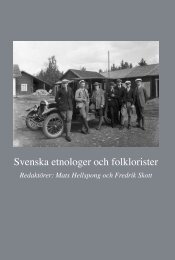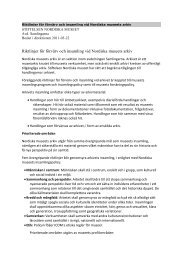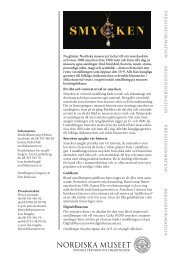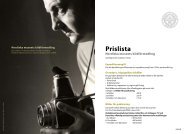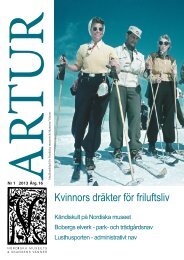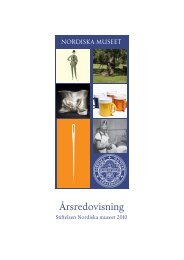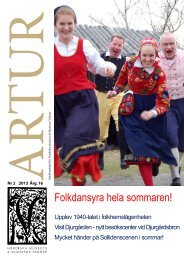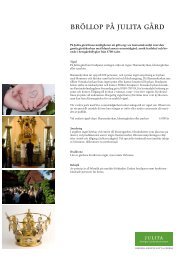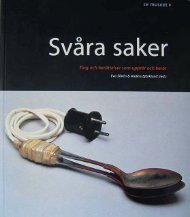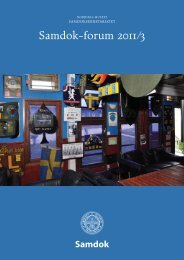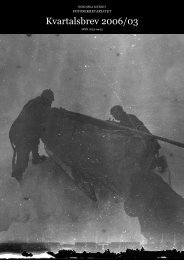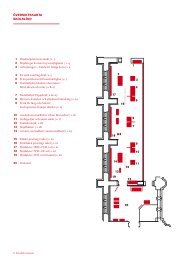Samdok - Nordiska museet
Samdok - Nordiska museet
Samdok - Nordiska museet
You also want an ePaper? Increase the reach of your titles
YUMPU automatically turns print PDFs into web optimized ePapers that Google loves.
Opening and welcome addresses<br />
contexts. How can they use these collections to discuss issues<br />
of relevance for people today, and how should new acquisitions<br />
correspond with already existing collections?---<br />
We believe that an intensified and extended dialogue and<br />
collaboration across borders would be beneficial for the<br />
development of museum practices, and we therefore invite<br />
museum professionals and scholars to the conference in<br />
November 2007 and to initial discussions on the formation<br />
of a Collecting Network for museums of cultural and social<br />
history.”<br />
And here we are together looking forward to two days of<br />
intense dialogue and, hopefully, future cooperation!<br />
Many of our old museums, like <strong>Nordiska</strong> Museet,<br />
were founded under the impression of the flourishing<br />
patriotic movements of the nineteenth century. Many<br />
old and new nation states wanted to establish and express<br />
their cultural identity after centuries of wars, occupation,<br />
maybe disruption. There was a strong wish to<br />
preserve the cultural heritage for future generations.<br />
Many times, as here in Sweden, this was achieved<br />
at the last minute in the period of industrialization, urbanization<br />
and emigration – 20 per cent of our population<br />
emigrated because of poverty and lack of freedom.<br />
Strong actors in this struggle for our national culture<br />
were popular movements, the homestead movement and<br />
the handicraft movement – along with our schools and<br />
universities.<br />
Today we see a similar movement in the nations that<br />
have achieved independence during the last 50–60 years.<br />
When the United Nations was founded in 1945 it had 51<br />
members – today nearly 200. Many of these ‘new’ nations<br />
have experienced colonialism, oppression, exploitation,<br />
poverty, maybe also civil war and cruel dictators.<br />
It is evident for many reasons that they want to manifest<br />
their cultural heritage and identity. Many of these countries<br />
are also in the process of radical economic and social<br />
changes creating economic development and threats<br />
to their cultural traditions.<br />
Today we live in a new world where cultures meet<br />
in countries and across boarders. Many nation states<br />
include many peoples with different languages, traditions,<br />
religions. Some peoples live in different states, as<br />
the Sami people here in Norway, Sweden, Finland and<br />
Russia or the Kurds in the Middle East. Most of us live in<br />
a multicultural environment.<br />
This has not always been the case. When I was a<br />
schoolgirl and a young woman, Sweden was still an extremely<br />
homogeneous society. The outside world was<br />
unknown and foreigners very rare. Less than 10 per cent<br />
could speak any other language than Swedish. We had<br />
a Lutheran State Church and its faith was taught in our<br />
schools. Other religions were detested. There was nothing<br />
like rights for minorities.<br />
This has all changed. Today all children learn English<br />
in school – most of them two or more languages. Twenty<br />
per cent of our inhabitants are immigrants from all parts<br />
of the world. More than 100 nationalities live in Sweden.<br />
Their children have the right to learn their mother tongue<br />
in school – together with Swedish and English. The rights<br />
of the minorities – the Sami people, the Swedish Finns,<br />
the Tornedalers, the Roma and the Jews – have been protected<br />
by law since 1999 when we became partners of the<br />
European Charter for Regional and Minority Languages<br />
and The Framework Convention for the Protection of<br />
National Minorities. It was one of my most rewarding<br />
experiences as Speaker of the Swedish Parliament to preside<br />
over the session where these decisions were taken<br />
with representatives of all these groups in their traditional<br />
dresses present in the galleries of the plenary. Just now<br />
our main exhibition SÁPMI tells the story of the Sami<br />
people. We do not have a state church. Religions live side<br />
by side. The Catholic Church is our second biggest denomination,<br />
Islam the third. Three of my grandchildren<br />
live in a suburb of Stockholm, Rinkeby, where 90 per<br />
cent of the inhabitants are immigrants and the Muslim<br />
children an absolute majority in the schools.<br />
This is a new reality, a major change that has taken<br />
place during two generations. We cannot ignore that we<br />
do have some problems with relations and integration.<br />
But none the less, there is no doubt that our ‘new Swedes’<br />
and our new contacts with the rest of the world, with<br />
other cultures and religions, have greatly enriched our<br />
life – in daily details as well as in the perception of the<br />
world. This has given us new chances, new experiences,<br />
and new challenges to form our identity.<br />
10



